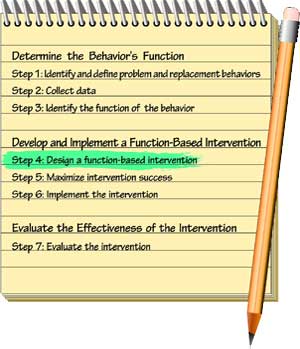What can Ms. Rollison do to modify Joseph’s behavior?
Page 9: Design a Function-Based Intervention
 Once a hypothesis to explain the function of the problem or target behavior has been developed, it’s time to move on to the fourth step in the FBA process: designing a function-based intervention. This process often includes teaching or reinforcing a replacement behavior that serves the same function as the problem behavior.
Once a hypothesis to explain the function of the problem or target behavior has been developed, it’s time to move on to the fourth step in the FBA process: designing a function-based intervention. This process often includes teaching or reinforcing a replacement behavior that serves the same function as the problem behavior.
Teachers seeking to determine exactly which type of intervention is needed might find it helpful to answer these two questions:
- Can the student perform the replacement behavior? It is necessary to determine whether the student can’t do the behavior or won’t do the behavior.
- Is there anything that the teacher can change in this classroom (i.e., antecedent conditions) to set the stage for the replacement behavior to occur? Such changes might include modifications to the room arrangement, to teacher instruction, to instructional materials, or to any other factors that might act as a trigger for the problem behavior or that might promote the replacement behavior.
The table below illustrates the circumstances under which a team might select a particular intervention. Regardless of the type of intervention selected, however, a teacher might need to:
- Adjust the antecedents to provide opportunities for the replacement behavior to occur
- Modify the consequences to 1) reinforce the replacement behavior, and 2) not reinforce the problem behavior (i.e., extinction)
If… |
Then use a(n)… |
Examples
|
|---|---|---|
| The student is unable to perform replacement behavior | Skill-based intervention to teach the replacement behavior | Click here for more details and an example of a skill-based intervention. |
| Antecedent conditions trigger the problem behavior | Antecedent-based intervention to adjust the antecedent | Click here for more details and an example of an antecedent-based intervention. |
| Consequences reinforce the problem behavior | Consequence-based intervention to modify the consequences | Click here for more details and an example of a consequence-based intervention. |
Skill-based intervention
At times, a student cannot do the task because he or she does not have the necessary skills. In such instances, the teacher can implement a skill-based intervention which:
- Teaches the student the missing skills (e.g., academic, social, organizational)
Some modifications to antecedents and consequences are often necessary. For example, a teacher may not require a student to perform a task that is not in his or her repertoire. The teacher would also need to reinforce instances of the displayed skill and take care not to reinforce the problem behavior.
Example
| Problem behavior | A student makes rude and disrespectful comments whenever she is asked to read aloud in class. |
| Function | Task avoidance |
| Replacement behavior | Once she has acquired the requisite reading skills, the student will read aloud in class when called on. |
| Teach skill |
Because the student lacks the requisite reading skills, the teacher will:
|
| Adjust antecedent | The teacher will not call on the student to read aloud if she has not had the opportunity to preview the material, or if she has not acquired the necessary reading skills. |
| Modify consequences |
1) Reinforce the replacement behavior Once the student has acquired the requisite reading skills, the teacher will reinforce the replacement behavior (reading aloud). 2) Do not reinforce the problem behavior (i.e., extinction) If the teacher does not call on the student to read aloud (antecedent adjustment) until her reading has improved (skill instruction) then it is likely that she will not engage in the problem behavior. However, if the problem behavior reoccurs, the teacher will withhold reinforcement. |
(Close this panel)
Antecedent-based intervention
In some cases, the teacher may implement an antecedent-based intervention. This involves making changes to the setting or situation in order to address the problem behavior. A teacher who implements an antecedent-based intervention could make adjustments in classroom routines and procedures to:
- Eliminate triggers for the problem behavior
- Provide more opportunities for the student to display the replacement behavior
Although this is an antecedent-based intervention, the teacher will still need to monitor consequences to make certain that she reinforces instances of the replacement behavior and withholds reinforcement for the problem behavior.
Example
| Problem behavior | When presented with multiple academic tasks, a student responds by scribbling on the papers, by tearing them up, or by proclaiming that he won’t do the work and that the teacher can’t make him. |
| Function | Task avoidance |
| Replacement behavior | When presented with multiple academic tasks, the student will complete the assigned tasks. He will raise his hand to request a break when he feels overwhelmed. |
| Teach skill | N/A |
| Adjust antecedent |
The student becomes overwhelmed by multiple assignments. Therefore, the teacher will eliminate possible triggers by:
|
| Modify consequences |
1) Reinforce the replacement behavior The teacher will provide positive reinforcement when the student raises his hand to request a break, the duration of which will be faded over time. 2) Do not reinforce the problem behavior (i.e., extinction) The teacher will not allow the student to avoid work by scribbling, tearing apart his papers, or refusing to work. |
(Close this panel)
Consequence-based intervention
In some cases, the teacher may implement a consequence-based intervention. This involves adjusting the consequences that affect the problem behavior. Specifically, a teacher:
- Provides reinforcement for the replacement behavior
- Withholds the consequence that previously reinforced the problem behavior
Although this is a consequence-based intervention, the teacher may still need to make adjustments to the antecedents so that the replacement behavior is more likely to occur.
Example
| Problem behavior | When presented with academic tasks, a student whines, complains that the work is too hard, or engages in mildly disruptive behaviors such as foot-tapping, pencil-tapping, or clicking her tongue. |
| Function | Teacher attention |
| Replacement behavior | When presented with academic tasks, the student will work quietly to complete them. |
| Teach skill | N/A |
| Adjust antecedent | The teacher will assign tasks that are within the student’s ability level. |
| Modify consequences |
1) Reinforce the replacement behavior
The teacher will give the student attention when she begins working on a task. 2) Do not reinforce the problem behavior (i.e., extinction)
|
(Close this panel)
Earlier in the module, you learned that extinction—when used alone—is problematic and difficult to implement. However, when used as one component of a comprehensive intervention, it can be quite useful.
 Let’s consider a function-based intervention for David. Recall the following hypothesis statement about his behavior:
Let’s consider a function-based intervention for David. Recall the following hypothesis statement about his behavior:
The primary motivator for David’s off-task behavior (e.g., walking around the room, talking with peers) is to avoid class work. To a lesser extent, he also seeks to obtain peer attention.
After reviewing the data further, the team determines that David does in fact possess the prerequisite skills to complete his assignments. They also determine that a specific antecedent—in this case, the assignment of independent work—triggers David’s off-task behavior. In response, they develop an antecedent-based intervention.
| Problem behavior | Off-task—participation in activities that are not part of the teacher-assigned instructional activity |
| Function | Task-avoidance (primary), peer attention (secondary) |
| Replacement behavior | On-task—engagement in teacher-assigned activities that are part of the instructional activity |
| Teach skill | N/A |
| Adjust antecedent |
After the teacher assigns independent seatwork, she will provide support to David by:
|
| Modify consequences |
1) Reinforce the replacement behavior After David works for 2–3 minutes, the teacher will allow him to take a brief pause from his classwork while she checks it. 2) Do not reinforce the problem behavior (i.e., extinction) The teacher will not allow David to avoid work by wandering around the room or talking to his peers. |
This intervention addresses the problem behavior in a number of ways. First, it breaks David’s work into smaller tasks, which are less overwhelming. Though two minutes may seem like a short time for David to work, his baseline data indicate that he is unable to stay on task for even this short amount of time. Second, David receives reinforcement in the form of a brief pause from the task (e.g., 20–30 seconds in his seat) during which time his teacher checks his work. The pause serves the same task-avoidance function as his previous off-task behavior but is a part of the natural classroom routine and less disruptive than David’s wandering around the room or talking to Angelina. Third, the intervention requires that David stay in his seat rather than walk to the teacher’s desk. This eliminates the potential for him to wander around the room. Once David has successfully demonstrated his ability to stay on task for two minutes, his teacher will gradually increase the time that he is required to work, with the goal of maintaining on-task behavior for the entire independent work period.
 This intervention addresses the primary function of David’s behavior (i.e., to avoid work). The team expects that the intervention, by keeping David engaged in his work, will also address the secondary function of his behavior (to seek attention). If the data show that the intervention is working, the teacher will continue to implement it. If, however, his problem behavior remains unchanged or increases, the team will modify his intervention. This intervention addresses the primary function of David’s behavior (i.e., to avoid work).
This intervention addresses the primary function of David’s behavior (i.e., to avoid work). The team expects that the intervention, by keeping David engaged in his work, will also address the secondary function of his behavior (to seek attention). If the data show that the intervention is working, the teacher will continue to implement it. If, however, his problem behavior remains unchanged or increases, the team will modify his intervention. This intervention addresses the primary function of David’s behavior (i.e., to avoid work).
The team summarizes the information above into a function-based intervention plan. This becomes a tool to effectively communicate the basic information necessary to implement and monitor the intervention. Click here to view David’s function-based intervention plan.
Keep in Mind
A behavior may serve more than one function. In such cases, the team must ensure that the intervention(s) addresses both functions. Failure to account for one function could result in an ineffective intervention.
Activity
 Here is the information gathered by the S-team about Joseph so far:
Here is the information gathered by the S-team about Joseph so far:
Joseph’s problem behaviors:
- Joseph makes sarcastic and teasing comments to other students during class.
- Joseph makes rude comments when called upon or spoken to by the teacher.
Joseph’s replacement behaviors:
- Joseph will listen without commenting when other students answer questions in class.
- Joseph will respond in a positive and respectful manner when called upon or spoken to by the teacher.
Summary of data: Classroom practices are evidence-based. Ms. Rollison has a strong classroom management plan and implements it well. Interviews and rating scales indicate that Joseph enjoys peer attention.
Possible function of the behavior: To gain peer attention
The following function-based intervention is designed for Joseph:
The class will be instructed to ignore instances of Joseph’s sarcastic, teasing, or rude comments. When these instances occur, the students will not laugh, smile, or acknowledge the comments in any way.
Critique the plan developed for Joseph. What type of intervention has the team designed? Why do you think they chose this type of intervention? Do you think this plan will be effective? What would you change, if anything? Explain your responses.
First, the team needs to ask:
- Can the student perform the replacement behavior?
- Are there things that the teacher can change in this classroom (antecedent conditions) to set the stage for the replacement behavior to occur?
The data indicate that Joseph is capable of doing the work but is choosing not to and that antecedent conditions reflect effective practices. This being the case, neither a skill-based nor an antecedent-based intervention is necessary.
The team has selected a consequence-based intervention. Though it does address the function of Joseph’s behavior, it is lacking other key elements of an effective intervention. The team has chosen to use extinction in isolation, which is often ineffective. In this case, it could prove difficult to get the entire class to effectively ignore Joseph’s behavior. In addition, the plan does not include antecedent adjustments or a method for reinforcing Joseph’s replacement behavior.
The following plan for Joseph is more likely to succeed:
| Problem behavior |
Joseph makes:
|
| Function | To obtain peer attention |
| Replacement behavior |
Joseph will:
|
| Teach skill | N/A |
| Adjust antecedent |
Ms. Rollison will:
|
| Modify consequences |
1) Reinforce the replacement behavior
2) Do not reinforce the problem behavior (i.e., extinction)
|